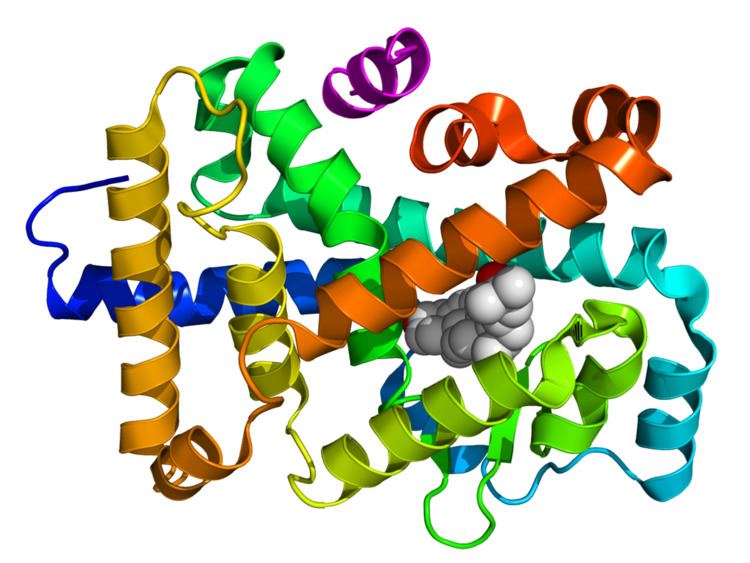Entrez 6097 | Ensembl ENSG00000143365 | |
 | ||
Aliases RORC, NR1F3, RORG, RZR-GAMMA, RZRG, TOR, RAR-related orphan receptor gamma, IMD42, RAR related orphan receptor C External IDs MGI: 104856 HomoloGene: 21051 GeneCards: RORC | ||
RAR-related orphan receptor gamma (RORγ) is a protein that in humans is encoded by the RORC (RAR-related orphan receptor C) gene. RORγ is member of the nuclear receptor family of transcription factors.
Contents
Gene expression
Two isoforms are produced from the same RORC gene, probably by selection of alternative promoters.
RORγ
The mRNA of the first isoform, RORγ is expressed in many tissues, including thymus, lung, liver, kidney, muscle, and brown fat. While RORγ mRNA is abundantly expressed, attempts to detect RORγ protein have not been successful; therefore it is not clear whether RORγ protein is actually expressed. Consistent with this, the main phenotypes identified in RORγ-/- knockout mice (where neither isoform is expressed) are those associated with RORγt immune system function and an isoform specific RORγt knockout displayed a phenotype identical to the RORγ-/- knockout. On the other hand, circadian phenotypes of RORγ-/- mice in tissues where the RORγt isoform is expressed in minute amounts argues for the expression of functional RORγ isoform. Absent protein in previous studies may be due to the high amplitude circadian rhythm of expression of this isoform in some tissues.
The mRNA is expressed in various peripheral tissues, either in a circadian fashion (e.g., in the liver and kidney) or constitutively (e.g., in the muscle).
In contrast to other ROR genes, the RORC gene is not expressed in the central nervous system.
RORγt
The tissue distribution of the second isoform, RORγt, appears to be highly restricted to the thymus where it is expressed exclusively in immature CD4+/CD8+ thymocytes and in lymphoid tissue inducer (LTi) cells. RORγt inhibitors are under development for the treatment of autoimmune diseases such as psoriasis and rheumatoid arthritis.
Function
The RORγ protein is a DNA-binding transcription factor and is a member of the NR1 subfamily of nuclear receptors. Although the specific functions of this nuclear receptor have not been fully characterized yet, some roles emerge from the literature on the mouse gene.
The RORγ isoform appears to be involved in the regulation of circadian rhythms. This protein can bind to and activate the promoter of the ARNTL (BMAL1) gene, a transcription factor central to the generation of physiological circadian rhythms. Also, since the levels of RORγ are rhythmic in some tissues (liver, kidney), it has been proposed to impose a circadian pattern of expression on a number of clock-controlled genes, for example the cell cycle regulator p21.
RORγt is the most studied of the two isoforms. Its best understood functionality is in the immune system. The transcription factor is essential for lymphoid organogenesis, in particular lymph nodes and Peyer's patches, but not the spleen. RORγt also plays an important regulatory role in thymopoiesis, by reducing apoptosis of thymocytes and promoting thymocyte differentiation into pro-inflammatory T helper 17 (Th17) cells. It also plays a role in inhibiting apoptosis of undifferentiated T cells and promoting their differentiation into Th17 cells, possibly by down regulating the expression of Fas ligand and IL2, respectively .
Despite the pro-inflammatory role of RORγt in the thymus, it is expressed in a Treg cell subpopulation in the colon, and is induced by symbiotic microflora. Abrogation of the gene's activity generally increases type 2 cytokines and may make mice more vulnerable to oxazolone-induced colitis.
Ligands
Various oxysterols and in particular the cholesterol percursor desmosterol is claimed to be the endogenous activator of RORγ. As antagonism of the RORγ receptor may have therapeutic applications in the treatment of inflammatory diseases, a number of synthetic RORγ receptor antagonists have been developed.
